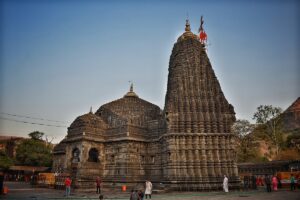
Trimbakeshwar or Tryambakeshwar is an ancient Hindu temple in the town of Trimbak, in the Trimbakeshwar tehsil in the Nashik District of Maharashtra, India, 28 km from the city of Nashik and 40 km from nashik road.
A sanskrit shloks says that anybody who visits Trimbakeshwar attains salvation. There is no sacred place like Trimbakeshwar, no river like Godavari, no mountain like Brahmagiri etc. The reasons for its being so sacred are – Godavari river originates in this place, its a place of Tri-Sandhya Gayatri, the birth place of Lord Ganesha, a place of the first Nath of Nath Sampradaya consisting of Gorakhnath and others, a place where Nivrittinath was made to imbibe the holy knowledge by his Guru Gahininath, a place where Nivrittinath made his brothers and sister attain the self by his preaching. This is the holiest place to perform Shradh ceremony. Nirnaya Sindhu – a religious book of Hindus, mentions that this place, where Sahyadri mountain and Godavari river exist is very purifying on the whole earth and is therefore very important for performing Shradh ceremony.
Counted as the holiest temple of India, the Trimbakeshwar Temple houses one of the most important twelve Jyotirlingas, a form of Lord Shiva. Perched on the foot of Brahmagiri Hills, the temple is situated in the pious city of Trimbak, which finds its mention in the powerful Mrityunjaya Mantra that bestows immorality and longevity. Built in the 18th century by Maratha ruler, Peshwa Nana Saheb, the temple is a perfect epitome of classic architecture.
The temple is located between three hills namely Brahmagiri, Nilagiri and Kalagiri. The temple has three lingams (an iconic form of Shiv) representing Shiv, Vishnu and Brahma. The temple tank is called Amritavarshini, which measured 28 m (92 ft) bu 30 m (98 ft). There are three other bodies of water, namely, Bilvatheertha, Viswananthirtha and Mukundathirtha. There are images of various deities, namely, Gangadevi, Jaleswara, Rameswara, Gautameswara, Kedarnatha, Rama, Krishna, Parasurama and Lakshmi Narayana. The temple has also several monasteries and samadhis of saints.
Different mythologies point to one common incident of an extremely long famine, effects of which could not affect Sage Gautama, one of the Saptrishi and his wife because of his high merits. From here on two versions split. First version tells about increasing merits of the sage because he chose to serve food selflessly to the other sages which made Indra worried and thus he ordered for the famine to be ended. However, the sage continued to earn merits by asking the rishis to eat at his place, a request that was granted. When Jaya, a friend of Goddess Parvati got killed by a sharp grass for grazing the field in the form of a frail cow by the Sage Gautama, he had to perform penance of his sin of ‘Gau Hatya’ – killing of a Cow to bring Goddess Ganga from the deadlocks of Lord Shiva down to earth to wash away his sin. Lord Shiva after becoming happy with the penance rewarded what was asked from him for greater good. And then Lord manifested here on the banks of River Gautami to take care of the place forever.
The other version is about Lord Ganesha becoming the cow on the request of the rishis and their wives jealous of the merits of Sage Gautama and dying forcing the sage to please Lord Shiva with his penance and bring Ganga to earth. Delighted Lord Shiva appeared with all the gods and goddesses and said to have remained here since then in the form of Jyotirlinga of Trimbakeshwar, hence the story of 33 Crore Gods and Goddesses staying here making it as popular as a pilgrimage place could get.
Attractions
Trimbakeshwar Jyotirlinga Temple: Unique among all the Shiva temple and Jyotirlingas in its appearance, the temple has a hole in place of Lingam inside which three ‘pindis’ (stone representing Gods) could be seen, one for each of the Holy Trinity- Creator Brahma, Operator Vishnu and Destroyer Shiva. Carved in black stone, temple unconsciously inspires devotion.
Kushavarta – the place from where river Godavari takes its course. A dip in this sacred river wipes off the sins, is the belief of people. The sage Gautam committed a sin of murdering a cow and by taking bath in this river, wiped off his sin.
Festivals at Trimbakeshwar Temple
Some of the holiest and exciting festivals held in Trimbakeshwar Temple are-
The Kumbh Mela – It is one of the largest religious gatherings in the world. Held once in every 12 years, millions of pilgrims gather to take a dip in the Godavari. It was last held in the year 2015.
Mahashivaratri – Held in February or March, this is considered as the auspicious day on which Lord Shiva got married to Parvati. Devotees keep fast and sing bhajans throughout the day.
Tripuri Purnima – This festival takes place in the month of Karthik which is November or December. It is celebrated because Lord Shiva destroyed three demon cities which are known as Tripura.
Rath Poornima – Held in January-February, in the festival, the Panchamukhi Idol of Lord Trimbakeshwar is placed in a rath and then is taken around the town.
Rituals and Pooja at Trimbakeshwar Temple
Kaal Sarp Pooja – This pooja is performed for those people who face difficulties in life due to certain positions of planets between Rahu and Ketu.
Source:
https://www.holidify.com/places/nasik/trimbakeshwar-sightseeing-3063.html
https://www.tourmyindia.com/pilgrimage/tryambakeshwar.html
https://nashik.com/trimbakeshwar/


